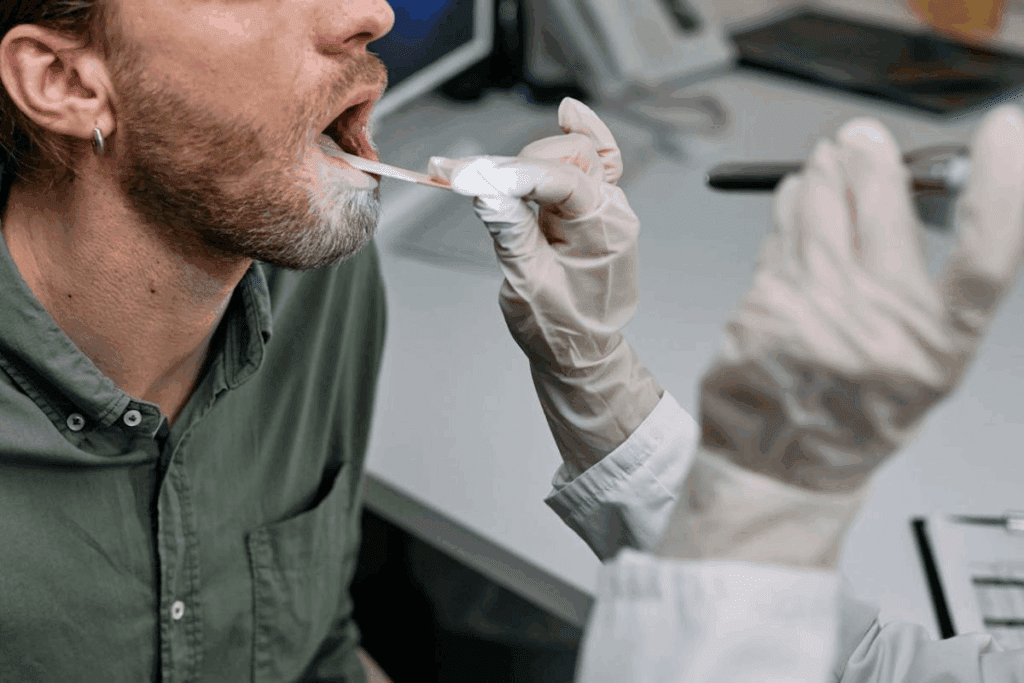Last Updated on November 27, 2025 by Ugurkan Demir

Oropharyngeal cancer is a type of head and neck cancer. It starts in the tissues of the oropharynx. The number of cases is going up, mainly because of its link to HPV.
Treatment options for ca oropharynx (oropharyngeal cancer), including surgery, radiation, and chemotherapy.
It’s important for patients and their families to know about all the treatment options. At Liv Hospital, we use a team approach. We follow the latest research to give top-notch care. This helps patients make informed decisions about their treatment.
As oropharyngeal cancer cases increase, it’s key to look at all the treatment choices. These include new robotic surgery and advanced immunotherapy.

Oropharyngeal cancer is a serious condition. It affects the malignant neoplasm of the oropharynx. This area includes many parts of the throat.
The oropharynx is key for swallowing and speaking. It includes the soft palate, the sides and back of the throat, the tonsils, and the back third of the tongue. Knowing the oropharynx’s anatomy helps us understand how cancer develops and spreads.
The oropharynx is the middle part of the throat, behind the mouth. It’s above the uvula and soft palate, below the tongue, and on the sides with the tonsils. The cells lining it are mostly squamous, which are often affected by cancer.
Oropharyngeal cancers are mainly classified by their cell of origin. The most common is squamous cell carcinoma, from squamous cells. Within this, there are keratinizing and non-keratinizing types, with non-keratinizing often linked to Human Papillomavirus (HPV) infection.
Type of Cancer | Description | Common Associations |
Squamous Cell Carcinoma | Arises from squamous cells lining the oropharynx | HPV infection, tobacco, and alcohol use |
Adenocarcinoma | Rare type originating from glandular cells | Less common, often related to other risk factors |
Lymphoma | Cancer of the immune cells | Can occur in the oropharynx, often associated with immunosuppression |
Knowing the different types of oropharyngeal cancers is key. It helps choose the right treatment and predict outcomes.

Understanding oropharyngeal cancer is key to better treatments. This type of head and neck cancer has changed a lot in recent years.
Oropharyngeal cancer cases are rising worldwide. In the U.S., there will be about 59,660 new cases and 12,770 deaths in 2025. This shows we need more research on this disease.
Key Statistics:
Men are more likely to get oropharyngeal cancer than women. It mostly affects people in their 50s and 60s. But, age can change with certain risk factors.
Human papillomavirus (HPV) is a big risk factor for oropharyngeal cancer. HPV-positive cancers act differently and have a better outlook than HPV-negative ones.
HPV Association Key Facts:
HPV is a big risk, but other factors matter too. These include tobacco, alcohol, and diet.
Non-HPV Risk Factors:
It’s important to know the signs and symptoms of oropharyngeal cancer. This helps in early detection and treatment. We will discuss the common signs that need a doctor’s check-up.
The early signs of oropharyngeal cancer can be hard to spot. They might include a sore throat that won’t go away or trouble swallowing. It’s key to notice these symptoms as they can be mistaken for other, less serious issues.
A sore throat that doesn’t get better with usual treatments could be a sign of cancer. If you have a sore throat that lasts, seeing a doctor is important.
Other signs might include ear pain and trouble swallowing. Here’s a table of common symptoms:
Symptom | Description |
Persistent Sore Throat | A sore throat that doesn’t improve with treatment |
Difficulty Swallowing | Trouble swallowing food or liquids |
Oropharyngeal Lump or Mass | A noticeable lump or swelling in the oropharynx |
Ear Pain | Unexplained pain in the ear |
If you keep getting these symptoms, you should see a doctor. Catching oropharyngeal cancer early can greatly improve treatment results.
“The key to managing oropharyngeal cancer lies in early detection and understanding the signs and symptoms that warrant medical attention.”
— Expert in Oncology
Diagnosing oropharyngeal cancer starts with a detailed physical check-up. This first step is key to spotting any signs of cancer. It helps us see if there are any unusual changes.
A thorough physical exam is done to check the patient’s health. We look closely at the mouth and throat area. Special tools help us see any tumors or unusual growths.
Imaging tests are very important for finding and understanding oropharyngeal cancer. CT scans, MRI, and PET scans
These tests give us important details for planning treatment. For example, a PET scan finds active tumor cells. This helps us know how to treat the cancer best.
A biopsy is needed to confirm oropharyngeal cancer. We take a tissue sample from the tumor. Then, a microscope checks for cancer cells. Knowing the cancer type and grade helps us choose the right treatment.
After confirming the diagnosis, we use the TNM staging system. It looks at the tumor size (T), lymph node involvement (N), and if the cancer has spread (M). This staging is key for planning treatment and predicting how well it will work.
Getting the staging right is important. It makes sure patients get the best treatment for their cancer. It also helps find patients for new treatments or clinical trials.
Surgery is key in treating oropharyngeal cancer. It offers different methods based on each patient’s needs. The choice of surgery depends on the cancer’s stage, location, and the patient’s health.
Traditional open surgery requires an incision in the neck to reach the oropharynx. It’s a tried-and-true method for tumors hard to reach by other means.
TORS is a new surgical tech that removes tumors through the mouth. It avoids external cuts, helping patients heal faster and with less scarring.
One big plus of TORS is its 3D, high-definition view of the surgery area. This helps surgeons remove tumors carefully, saving healthy tissue.
Minimally invasive surgeries, like endoscopic and laser methods, are alternatives to open surgery. They cause less damage and help patients recover quicker.
Neck dissection is often done with other surgeries to remove cancer from lymph nodes. The type of dissection needed depends on how many nodes are affected.
The table below highlights the main points of these surgical methods:
Surgical Approach | Description | Benefits |
Traditional Open Surgery | Involves an incision in the neck to access the oropharynx | Effective for tumors not easily accessible |
TORS | Removes tumors through the mouth without external incisions | Reduces recovery time and minimizes scarring |
Minimally Invasive Techniques | Includes endoscopic and laser surgeries | Less tissue damage, quicker recovery |
Neck Dissection | Removes lymph nodes that may contain cancer cells | Essential for managing cancer spread |
Radiation therapy is key in treating oropharyngeal cancer. It offers different ways to treat patients based on their needs. We aim to hit cancer cells hard while keeping healthy tissues safe.
External beam radiation therapy (EBRT) uses a source outside the body to beam radiation at the tumor. It’s great for treating big areas if needed.
EBRT is good for oropharyngeal cancer because it can match the tumor’s shape and size. This helps save the tissues around it.
Intensity-Modulated Radiation Therapy (IMRT) is a high-tech version of EBRT. It changes the intensity of the beams for better accuracy. This means less damage to nearby important areas.
IMRT is great for oropharyngeal cancer patients. It can help avoid dry mouth by protecting the salivary glands.
Proton therapy uses protons to kill cancer cells, unlike X-rays. It delivers a precise dose to the tumor, reducing harm to other areas. This can lead to fewer side effects.
For oropharyngeal cancer, proton therapy is good for young patients. It helps lower long-term damage risks.
Brachytherapy puts radioactive material close to or inside the tumor. It gives a high dose of radiation right to the cancer. This method keeps the dose to nearby tissues low.
Brachytherapy can be used alone or with EBRT for oropharyngeal cancer. It offers a focused treatment approach.
Chemotherapy is key in fighting oropharyngeal cancer. It offers various ways to tackle the disease. We use it at different stages to help patients get better.
Induction chemotherapy is given before main treatments like surgery or radiation. It aims to shrink tumors and kill any hidden cancer cells. This makes later treatments more effective. We mix different chemotherapy drugs, like platinum-based and taxanes, for the best results.
Concurrent chemotherapy combines chemotherapy and radiation at the same time. This makes radiation work better by making cancer cells more vulnerable. It’s often used for more advanced cases of oropharyngeal cancer.
Adjuvant chemotherapy is given after the main treatment, like surgery. It aims to get rid of any cancer cells left behind. This lowers the chance of cancer coming back and improves survival chances. The choice to use it depends on the cancer’s stage and the patient’s health.
Common treatments include mixing platinum-based drugs (like cisplatin) with taxanes (such as docetaxel). The right mix depends on the patient’s condition and cancer stage. We customize each treatment plan for the best results.
Understanding how chemotherapy works in treating oropharyngeal cancer helps us give better care. We tailor our approach to meet each patient’s unique needs.
Multimodal treatment strategies are key in managing oropharyngeal cancer. Advances in oncology show that one treatment alone is not enough. A mix of treatments is needed for the best results.
Chemoradiation Therapy is a mainstay in treating oropharyngeal cancer. It combines chemotherapy and radiation. This combo makes treatment more effective, improving control and survival rates.
Chemoradiation therapy uses chemotherapy and radiation together. This method makes cancer cells more sensitive to radiation. Research shows it greatly improves outcomes for advanced oropharyngeal cancer patients.
“Chemoradiation therapy has changed how we treat oropharyngeal cancer,” say top oncologists. “It leads to better survival rates and quality of life for patients.”
Surgery combined with adjuvant therapy is another approach. Surgery removes the tumor and affected lymph nodes. Then, adjuvant therapy, like radiation or chemoradiation, kills any remaining cancer cells. This method works well for high-risk or advanced cases.
The choice of treatment depends on the cancer stage. Early-stage cancer might need just one treatment. But for more advanced stages, a mix of treatments is best. We carefully choose the right treatment for each patient based on their disease stage.
Personalized treatment planning is vital in multimodal treatment. We consider HPV status, tumor biology, and patient preferences. This approach improves outcomes and quality of life for each patient.
In summary, multimodal treatments like chemoradiation and surgery with adjuvant therapy are essential for oropharyngeal cancer. Choosing the right treatment based on the disease stage and personalizing it leads to the best results for our patients.
Oropharyngeal cancer treatment is on the verge of a big change with new therapies. Research is moving fast, bringing new ways to fight cancer. These new methods aim to target cancer more effectively.
Immunotherapy is showing great promise for treating oropharyngeal cancer. It uses the body’s immune system to fight cancer cells. Checkpoint inhibitors like pembrolizumab and nivolumab are proving to be very effective.
“The integration of immunotherapy into the treatment paradigm for oropharyngeal cancer represents a significant advancement in our fight against this disease,” says Dr. [Last Name], a leading oncologist. “By leveraging the body’s immune response, we can potentially achieve more durable responses and improved survival.”
Targeted molecular therapies are also showing great promise. These treatments aim at specific changes in cancer cells that help them grow. For example, EGFR inhibitors have shown success in treating some head and neck cancers.
These therapies can be used alone or with other treatments. Researchers are working hard to find the best targets and develop new agents.
Many clinical trials are exploring new treatments for oropharyngeal cancer. These trials are looking at different approaches, including new immunotherapies and targeted therapies.
Knowing if a person has HPV is key to picking the right treatment for oropharyngeal cancer. The human papillomavirus (HPV) plays a big role in this cancer. Whether it’s there or not affects how well a patient will do and what treatments they might need.
People with HPV-positive oropharyngeal cancer usually do better than those without it. Research shows HPV-positive patients live longer and respond better to treatment. This is because HPV-positive tumors act differently and are easier to treat.
The good news for HPV-positive patients comes from several places:
For HPV-positive oropharyngeal cancer, treatments are designed to take advantage of the better outlook. Current methods include:
HPV-negative oropharyngeal cancers, on the other hand, get more aggressive treatments. This is because they have a worse outlook. Treatment options might include:
Researchers are exploring ways to make treatments for HPV-positive oropharyngeal cancer less harsh. This aims to keep cure rates high while lowering side effects. Some ideas include:
As studies keep advancing, we’ll likely see even better treatments for oropharyngeal cancer based on HPV status. This could lead to better lives for those affected by this disease.
Knowing the different ways to treat oropharyngeal cancer is key to managing the disease well. We’ve looked at treatments like radiation, surgery, chemoradiation, and chemotherapy. Each one plays a part in fighting this complex illness.
HPV’s link to oropharyngeal cancer is important for predicting outcomes and choosing treatments. People with HPV-positive cancer tend to do better and might get less intense treatments. Those with HPV-negative cancer might need stronger treatments.
As we learn more about oropharyngeal cancer and its treatments, we must focus on each patient’s needs. This means considering their unique situation and preferences when planning treatment. This approach helps improve treatment results and enhances patients’ quality of life.
Oropharyngeal cancer is a type of cancer. It affects the oropharynx, which is the middle part of the throat. This includes the tonsils, base of the tongue, and walls of the pharynx.
Signs and symptoms include a sore throat that doesn’t go away. You might also have trouble swallowing or ear pain. A lump in the neck or a sore in the oropharynx are other symptoms.
Doctors use a physical exam and imaging studies like CT or MRI scans. They also do biopsies to find cancer cells.
Human papillomavirus (HPV) is a big risk factor for oropharyngeal cancer. It’s most common in cancers of the tonsils and base of the tongue.
Treatments include surgery, radiation therapy, and chemotherapy. The choice depends on the cancer’s stage and HPV status.
TORS is a new surgery method. It uses a robotic system to remove tumors from the oropharynx. This method is less invasive than traditional surgery.
Radiation therapy kills cancer cells with high-energy beams. It can be given from outside the body or placed inside through brachytherapy.
Knowing if you have HPV is very important. It helps doctors decide the best treatment. HPV-positive patients often have a better chance of recovery.
Yes, oropharyngeal cancer can be cured. Early diagnosis and new treatments have made it possible. Treatment results have gotten better over time.
New treatments include immunotherapy and targeted molecular therapies. There are also ongoing clinical trials. These aim to improve treatment results and reduce side effects.
The stage is found using the TNM system. It looks at the tumor’s size, lymph node involvement, and if it has spread.
Chemoradiation therapy combines chemotherapy and radiation therapy. It’s a way to make treatment more effective.
Yes, there are clinical trials for new treatments. These include immunotherapy and targeted therapies for oropharyngeal cancer.
National Center for Biotechnology Information. (2025). What Are the Treatment Options for Oropharyngeal Cancer. Retrieved from https://pmc.ncbi.nlm.nih.gov/articles/PMC9415053/
Subscribe to our e-newsletter to stay informed about the latest innovations in the world of health and exclusive offers!